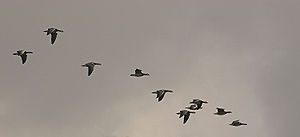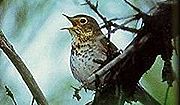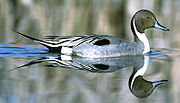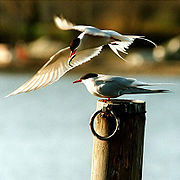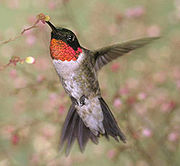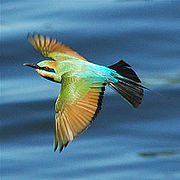
Bird migration
Background to the schools Wikipedia
The articles in this Schools selection have been arranged by curriculum topic thanks to SOS Children volunteers. SOS mothers each look after a a family of sponsored children.
Bird migration refers to the regular seasonal journeys undertaken by many species of birds. Migrations include movements of varied distances made in response to changes in food availability, habitat or weather. These however are usually irregular or in only one direction and are termed variously as nomadism, invasions or irruptions. Migration is marked by its annual seasonality. In contrast, birds that are non-migratory are known as resident birds.
General patterns
Many land birds migrate long distances. The most common pattern involves flying north to breed in the temperate or Arctic summer and returning to wintering grounds in warmer regions to the south.
The primary advantage of migration is energetic. The longer days of the northern summer provide greater opportunities for breeding birds to feed their young. The extended daylight hours allow diurnal birds to produce larger clutches than related non-migratory species that remain in the tropics year-round. As the days shorten in autumn, the birds return to warmer regions where the available food supply varies little with the season.
These advantages offset the high stress, energetic costs, and other risks of the migration. Predation can be heightened during migration; the Eleonora's Falcon which breeds on Mediterranean islands has a very late breeding season, coordinated with the autumn passage of southbound passerine migrants which it feeds to its young. A similar strategy is adopted by the Greater Noctule bat, which preys on nocturnal passerine migrants. The higher concentrations of migrating birds at stopover sites also make them prone to parasites and pathogens requiring a heightened immune response.
Within a species not all populations may be migratory and this is termed as partial migration. Partial migration is very common in the southern continents; in Australia, 44% of non-passerine birds and 32% of passerine species were partially migratory. In some species the population at higher latitudes tend to be migratory and will often winter at lower latitude past the latitudes where other populations may be sedentary, with suitable wintering habitats already occupied, and this is termed as leap-frog migration. Within a population, there can also be different patterns of timing and migration based on the age groups and sex. Only the female Chaffinches in Scandinavia migrate with the males staying resident. This has given rise to its specific name coelebs, a bachelor.
Most migrations begin with the birds starting off in a broad front. In some cases the migration may involve narrow belts of migration that are established as traditional routes termed as flyways. These routes typically follow mountain ranges or coastlines, and may take advantage of updrafts and other wind patterns or avoid geographical barriers such as large stretches of open water. The specific routes may be genetically programmed or learnt to varying degrees. The routes taken on forward and return migration are often different.
Many of the larger birds fly in flocks. Flying in flocks helps in reducing the energy needed. Many large birds fly in a V-formation and individual energy savings have been estimated in the range 12–20. Red Knots Calidris canutus and Dunlins Calidris alpina were found in radar studies to fly 5 km per hour faster in flocks than when they were flying solitarily.
The altitude at which birds fly during migration varies. An expedition to Mt. Everest found skeletons of Pintail and Black-tailed Godwit at 5000 m (16,400 ft) on the Khumbu Glacier. Bar-headed Geese have been seen flying over the highest peaks of the Himalayas above 8000 m (29000 ft) even when low passes of 3000 m (10000 ft) were nearby. Seabirds fly low over water but gain altitude when crossing land and the reverse pattern is seen in landbirds. However most bird migration is in the range of 150 m (500 ft) to 600 m (2000 ft). Bird hit records from the United States show most collisions below 600 m (2000 ft) and almost none above 1800 m (6000 ft).
Most species of Penguin perform regular migrations by swimming. These routes can cover over 1000km. Blue Grouse Dendragapus obscurus perform altitudinal migration mostly by walking. Emus in Australia have been observed to undertake long-distance movements on foot during droughts.
Historical views
The earliest recorded observations of bird migration were 3000 years ago, as noted by Hesiod, Homer, Herodotus, Aristotle and others. The bible also notes migrations, as in the Book of Job (39:26), where the inquiry is made: "Doth the hawk fly by Thy wisdom and stretch her wings toward the south?" The author of Jeremiah (8:7) wrote: "The stork in the heavens knoweth her appointed time; and the turtledove, and the crane, and the swallow, observe the time of their coming."
Aristotle noted that cranes traveled from the steppes of Scythia to marshes at the headwaters of the Nile. Pliny the Elder in his Historia Naturalis repeats Aristotle's observations. Aristotle however suggested that swallows and other birds hibernated. This belief persisted as late as 1878, when Elliott Coues listed the titles of no less than 182 papers dealing with the hibernation of swallows. It was not until early in the nineteenth century that migration as an explanation for the winter disappearance of birds from northern climes was accepted.
The discovery of White Storks in Germany with African arrows embedded provided early clues on migration. One of the oldest of these Pfeilstorch specimens was found in 1822 near the German village of Klütz, in the state of Mecklenburg-Vorpommern.
Long-distance migration
The typical image of migration is of northern landbirds such as swallows and birds of prey making long flights to the tropics. Many northern-breeding ducks, geese and swans are also long-distance migrants, but need only to move from their Arctic breeding grounds far enough south to escape frozen waters. Most Holarctic wildfowl species remain in the Northern hemisphere, but in countries with milder climates. For example, the Pink-footed Goose migrates from Iceland to Britain and neighbouring countries. Migratory routes and wintering grounds are traditional and learned by young during their first migration with their parents. Some ducks, such as the Garganey, move completely or partially into the tropics.
The same considerations about barriers and detours that apply to long-distance land-bird migration apply to water birds, but in reverse: a large area of land without bodies of water that offer feeding sites is a barrier to a water bird. Open sea may also be a barrier to a bird that feeds in coastal waters. Detours avoiding such barriers are observed: for example, Brent Geese migrating from the Taymyr Peninsula to the Wadden Sea travel via the White Sea coast and the Baltic Sea rather than directly across the Arctic Ocean and northern Scandinavia.
A similar situation occurs with waders (called "shorebirds" in North America). Many species, such as Dunlin and Western Sandpiper, undertake long movements from their Arctic breeding grounds to warmer locations in the same hemisphere, but others such as Semipalmated Sandpiper travel huge distances to the tropics. Like the large and powerful wildfowl, the waders are strong fliers. This means that birds wintering in temperate regions have the capacity to make further shorter movements in the event of particularly inclement weather.
For some species of waders, migration success depends on the availability of certain key food resources at stopover points along the migration route. This gives the migrants an opportunity to "refuel" for the next leg of the voyage. Some examples of important stopover locations are the Bay of Fundy and Delaware Bay.
Some Bar-tailed Godwits have the longest non-stop flight of any migrant, flying 11,000 km to their New Zealand non-breeding areas (BTO News 258: 3, 2005). Prior to migration, 55 percent of their bodyweight is stored fat to fuel this uninterrupted journey.
Seabird migration is similar in pattern to those of the waders and waterfowl. Some, such as the Black Guillemot and some gulls, are quite sedentary; others, such as most terns and auks breeding in the temperate northern hemisphere, move varying distances south in winter. The Arctic Tern has the longest-distance migration of any bird, and sees more daylight than any other, moving from its Arctic breeding grounds to the Antarctic non-breeding areas. One Arctic Tern, ringed (banded) as a chick on the Farne Islands off the British east coast, reached Melbourne, Australia in just three months from fledging, a sea journey of over 22,000 km (14,000 miles). A few seabirds, such as Wilson's Petrel and Great Shearwater, breed in the southern hemisphere and migrate north in the southern winter. Seabirds have the additional advantage of being able to feed during migration over open waters.
The most pelagic species, mainly in the 'tubenose' order Procellariiformes, are great wanderers, and the albatrosses of the southern oceans may circle the globe as they ride the "roaring forties" outside the breeding season. The tubenoses spread widely over large areas of open ocean, but congregate when food becomes available. Many are also among the longest-distance migrants; Sooty Shearwaters nesting on the Falkland Islands migrate 14,000 km (9,000 miles) between the breeding colony and the North Atlantic Ocean off Norway. Some Manx Shearwaters do this same journey in reverse. As they are long-lived birds, they may cover enormous distances during their lives; one record-breaking Manx Shearwater is calculated to have flown 8 million km (5 million miles) during its over-50 year lifespan.
Some large broad-winged birds rely on thermal columns of rising hot air to enable them to soar. These include many birds of prey such as vultures, eagles, and buzzards, but also storks. These birds migrate in the daytime. Migratory species in these groups have great difficulty crossing large bodies of water, since thermals only form over land, and these birds cannot maintain active flight for long distances. The Mediterranean and other seas therefore present a major obstacle to soaring birds, which are forced to cross at the narrowest points. Massive numbers of large raptors and storks pass through areas such as Gibraltar, Falsterbo, and the Bosphorus at migration times. More common species, such as the Honey Buzzard, can be counted in hundreds of thousands in autumn. Other barriers, such as mountain ranges, can also cause funnelling, particularly of large diurnal migrants. This is a notable factor in the Central American migratory bottleneck.
Many of the smaller insectivorous birds including the warblers, hummingbirds and flycatchers migrate large distances, usually at night. They land in the morning and may feed for a few days before resuming their migration. The birds are referred to as passage migrants in the regions where they occur for short durations between the origin and destination.
By migrating at night, nocturnal migrants minimize predation, and avoid overheating that could result from the energy expended to fly such long distances. This also enables them to feed during the day and refuel for the night. One cost of nocturnal migration is the loss of sleep. Migrants may be able to alter their quality of sleep to compensate for the loss.
Short-distance migration
Many of the long-distance migrants in the previous section are effectively genetically programmed to respond to changing lengths of days. However, many species move shorter distances, but may do so only in response to harsh weather conditions.
Thus mountain and moorland breeders, such as Wallcreeper and White-throated Dipper, may move only altitudinally to escape the cold higher ground. Other species such as Merlin and Skylark will move further to the coast or to a more southerly region. Species like the Chaffinch are not migratory in Britain, but will move south or to Ireland in very cold weather.
Short-distance passerine migrants have two evolutionary origins. Those which have long-distance migrants in the same family, such as the Chiffchaff, are species of southern hemisphere origins which have progressively shortened their return migration so that they stay in the northern hemisphere.
Those species which have no long-distance migratory relatives, such as the waxwings, are effectively moving in response to winter weather, rather than enhanced breeding opportunities.
In the tropics there is little variation in the length of day throughout the year, and it is always warm enough for an adequate food supply. Apart from the seasonal movements of northern hemisphere wintering species, most species are in the broadest sense resident. However many species undergo movements of varying distances depending on the rainfall.
Many tropical regions have wet and dry seasons, the monsoons of India being perhaps the best known example. An example of a bird whose distribution is rain associated is the Woodland Kingfisher of west Africa.
There are a few species, notably cuckoos, which are genuine long-distance migrants within the tropics. An example is the Lesser Cuckoo, which breeds in India and spends the non-breeding season in Africa.
In the high mountains, such as the Himalayas and the Andes, there are also seasonal altitudinal movements in many species, and others may undertake migrations of considerable length. The Himalayan Kashmir Flycatcher and Pied Thrush both move as far south as the highlands of Sri Lanka.
Irruptions and dispersal
Sometimes circumstances such as a good breeding season followed by a food source failure the following year lead to irruptions, in which large numbers of a species move far beyond the normal range. Bohemian Waxwing and Common Crossbills are two species which show this unpredictable variation in annual numbers.
The temperate zones of the southern continents have extensive arid areas, particularly in Australia and western southern Africa, and weather-driven movements are common but not always predictable. A couple of weeks of heavy rain in one part or another of the usually dry centre of Australia, for example, causes dramatic plant and invertebrate growth, attracting birds from all directions. This can happen at any time of year, and, in any given area, may not happen again for a decade or more, depending on the frequency of El Niño and La Niña periods.
Bird migration is primarily, but not entirely, a Northern Hemisphere phenomenon. In the Southern Hemisphere, seasonal migration tends to be much less obvious. There are several reasons for this.
First, the largely uninterrupted expanses of land mass or ocean tend not to funnel migrations into narrow and obvious pathways, making them less obvious to the human observer. Second, at least for terrestrial birds, climatic regions tend to fade into one another over a long distance rather than be entirely separate: this means that rather than make long trips over unsuitable habitat to reach particular destinations, migrant species can usually travel at a relaxed pace, feeding as they go. Short of banding studies it is often not obvious that the birds seen in any particular locality as the seasons change are in fact different members of the same species passing through, gradually working their way north or south.
Many species do in fact breed in the temperate southern hemisphere regions and winter further north in the tropics. The southern African Greater Striped Swallow, and the Australian Satin Flycatcher, Dollarbird, and Rainbow Bee-eater for example, winters well north of their breeding range.
Physiology and control
The control of migration, its timing and response are genetically controlled and appear to be a primitive trait that is present even in non-migratory species of birds. The ability to navigate and orient themselves during migration is a much more complex phenomenon which may include both endogenous programs as well as learning.
Timing
The primary physiological cue for migration are the changes in the day length. These changes are also related to hormonal changes in the birds.
In the period before migration, many birds display higher activity or Zugunruhe (German: migratory restlessness) as well as physiological changes such as increased fat deposition. The occurrence of Zugunruhe even in cage-raised birds with no environmental cues (e.g. shortening of day and falling temperature) has pointed to the role of circannual endogenic programming in controlling bird migrations. Caged birds display a preferential flight direction that corresponds with the migratory direction they would take in nature, even changing their preferential direction at roughly the same time their wild conspecifics change course.

Navigation is based on a variety of senses. Many birds have been shown to use a sun compass. Using the sun for direction involves the need for making compensation based on the time. Navigation has also been shown to be based on a combination of other abilities including the ability to detect magnetic fields, use visual landmarks as well as olfactory cues.
Long distance migrants are believed to disperse as young birds and form attachments to potential breeding sites and to favourite wintering sites. Once the site attachment is made they show high site-fidelity, visiting the same wintering sites year after year.
The ability of birds to navigate during migrations cannot be fully explained by endogenous programming, even with the help of responses to environmental cues. The ability to successfully perform long-distance migrations can probably only be fully explained with an accounting for the cognitive ability of the birds to recognize habitats and form mental maps. Satellite tracking of day migrating raptors such as Ospreys and Honey Buzzards has shown that older individuals are better at making corrections for wind drift.
As the circannual patterns indicate, there is a strong genetic component to migration in terms of timing and route, but this may be modified by environmental influences. An interesting example where a change of migration route has occurred because of such a geographical barrier is the trend for some Blackcaps in central Europe to migrate west and winter in Britain rather than cross the Alps.
Migratory birds may use two electromagnetic tools to find their destinations: one that is entirely innate and another that relies on experience. A young bird on its first migration flies in the correct direction according to the Earth's magnetic field, but does not know how far the journey will be. It does this through a radical pair mechanism whereby chemical reactions in special photo pigments sensitive to long wavelengths are affected by the field. Note that although this only works during daylight hours, it does not use the position of the sun in any way. At this stage the bird is similar to a boy scout with a compass but no map, until it grows accustomed to the journey and can put its other facilities to use. With experience they learn various landmarks and this "mapping" is done by magnetites in the trigeminal system, which tell the bird how strong the field is. Because birds migrate between northern and southern regions, the magnetic field strengths at different latitudes let it interpret the radical pair mechanism more accurately and let it know when it has reached its destination. More recent research has found a neural connection between the eye and "Cluster N", the part of the forebrain that is active during migrational orientation, suggesting that birds may actually be able to see the magnetic field of the earth.
Vagrancy
Migrating birds can lose their way and occur outside their normal ranges. These can be due to flying past their destinations as in the "spring overshoot" in which birds returning to their breeding areas overshoot and end up further north than intended. A mechanism which can lead to great rarities turning up as vagrants thousands of kilometres out of range is reverse migration, where the genetic programming of young birds fails to work properly. Certain areas, because of their location, have become famous as watchpoints for migrating birds. Examples are the Point Pelee National Park in Canada, and Spurn in England. Drift migration of birds blown off course by the wind can result in "falls" of large numbers of migrants at coastal sites.
Migration conditioning
It has been possible to teach a migration route to a flock of birds, for example in re-introduction schemes. After a trial with Canada Geese, microlight aircraft were used in the US to teach safe migration routes to reintroduced Whooping Cranes.
Evolutionary and ecological factors
Whether a particular species migrates depends on a number of factors. The climate of the breeding area is important, and few species can cope with the harsh winters of inland Canada or northern Eurasia. Thus the partially migratory Blackbird Turdus merula is migratory in Scandinavia, but not in the milder climate of southern Europe. The nature of the staple food is also significant. Most specialist insect eaters outside the tropics are long-distance migrants, and have little choice but to head south in winter.
Sometimes the factors are finely balanced. The Whinchat Saxicola rubetra of Europe and the Siberian Stonechat Saxicola maura of Asia are long-distance migrants wintering in the tropics, whereas their close relative, the European Stonechat Saxicola rubicola is a resident bird in most of its range, and moves only short distances from the colder north and east. A possible factor here is that the resident species can often raise an extra brood.
Recent research suggests that long-distance passerine migrants are of South American and African, rather than northern hemisphere, evolutionary origins. They are effectively southern species coming north to breed rather than northern species going south to winter.
Theoretical analyses, summarized by Alerstam (2001), show that detours that increase flight distance by up to 20% will often be adaptive on aerodynamic grounds - a bird that loads itself with food in order to cross a long barrier flies less efficiently. However some species show circuitous migratory routes that reflect historical range expansions and are far from optimal in ecological terms. An example is the migration of continental populations of Swainson's Thrush, which fly far east across North America before turning south via Florida to reach northern South America; this route is believed to be the consequence of a range expansion that occurred about 10,000 years ago. Detours may also be caused by differential wind conditions, predation risk, or other factors.
Climate change
Large scale climatic changes are expected to have an effect on the timing of migration and studies have shown a variety of effects including timing changes in migration, breeding as well as population declines.
Ecological effects
The migration of birds also aids the movement of other species including those of ectoparasites such as ticks and lice, which in turn may carry micro-organisms including those of concern to human health. Considerable interest has been taken due to the global spread of avian influenza, however migrant birds have not been found to be a special risk, with import of pet and domestic birds being a greater threat. Some viruses that are maintained in birds without lethal effects, such as the West Nile Virus may however be spread by migrating birds. Birds may also have a role in the dispersal of propagules of plants and plankton.
Study techniques
Bird migration has been studied by a variety of techniques of which ringing is the oldest. Colour marking, use of radar, satellite tracking and stable Hydrogen (or Strontium) isotopes are some of the other techniques used to study migration.
An approach to identify migration intensity makes use of upward pointing microphones to record the nocturnal contact calls of flocks flying overhead. These are then analyzed in a laboratory to measure time, frequency and species.
An older technique to quantify migration involves observing the face of the moon towards full moon and counting the silhouettes of flocks of birds as they fly at night.
Studies of orientation behaviour have been traditionally carried out using variants of a setup known as the Emlen funnel which consists of a circular cage with the top covered by glass or wire-screen so that either the sky is visible or the setup is placed in a planetarium or with other controls on environmental cues. The orientation behaviour of the bird inside the cage is studied quantitatively using the distribution of marks that the bird leaves on the walls of the cage. Other approaches used in pigeon homing studies make use of the direction in which the bird vanishes on the horizon.
Threats and conservation
Human activities have threatened many migratory bird species. The distances involved in bird migration mean that they often cross political boundaries of countries and conservation measures require international cooperation. Several international treaties have been signed to protect migratory species including the Migratory Bird Treaty Act of 1918 of the US and the African-Eurasian Migratory Waterbird Agreement.
The concentration of birds during migration can put species at risk. Some spectacular migrants have already gone extinct, the most notable being the Passenger Pigeon (Ectopistes migratorius). During migration the flocks were a mile (1.6 km) wide and 300 miles (500 km) long, taking several days to pass and containing up to a billion birds.
Other significant areas include stop-over sites between the wintering and breeding territories. A capture-recapture study of passerine migrants with high fidelity for breeding and wintering sites did not show similar strict association with stop-over sites.
Hunting along the migratory route can also take a heavy toll. The populations of Siberian Cranes that wintered in India declined due to hunting along the route, particularly in Afghanistan and Central Asia. Birds were last seen in their favourite wintering grounds in Keoladeo National Park in 2002.
Structures such as power lines, wind farms and offshore oil-rigs have also been known to affect migratory birds. Habitat destruction by land use changes is however the biggest threat and shallow wetlands which are stopover and wintering sites for migratory birds are particularly threatened by draining and reclamation for human use.
